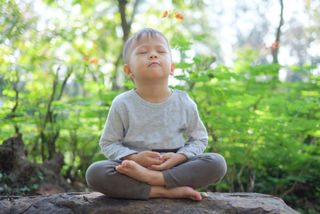ADHD
Mindfulness, ADHD, and Emotion: A Natural and Practical Fit
New research reflects the complexity of both mindfulness and ADHD.
Posted August 12, 2019

A new study shows benefit to children as young as seven years old with attention deficit hyperactivity disorder (ADHD) when they practice mindfulness. Perhaps surprisingly, the study is not really about attention. Instead, the researchers measured improvements around behavior and emotion. That’s because neither ADHD nor mindfulness specifically has to do with focus. On a much grander level, both ADHD and mindfulness impact all of our lives.
Two Sides of the Same Coin
It’s not uncommon to hear well-meaning mindfulness researchers suggest that since ADHD is an attention disorder then practicing focus through mindfulness should eliminate it. But ADHD isn’t an attention disorder. ADHD is a highly genetic medical disorder affecting an array of abilities related to executive function.
The executive function represents various cognitive traits used to navigate anything in life requiring self-regulation, organization, planning, and forethought. It’s often referred to as our "brain manager." ADHD, therefore, can affect anything that relies on managerial level cognitive skills: Attention, behavior, time, projects, goals, sustaining routines, emotion and more. Through those abilities, we oversee situations like our classroom learning, work, conversations, relationships, and even our physical health.
Mindfulness represents the other side of that same executive function-based coin. Better focus alone wouldn’t change our lives. We start with focus but also work on staying settled, observing our ever-changing experience, and on shifting various habits we uncover that affect how we live. The intention is to see life with clarity and to develop traits that help us manage with resilience and skill whatever we experience day-to-day.
Mindfulness, ADHD, and Emotion
Emotions are a vital part of life, and we all must learn to manage them as best as we’re able. Executive function-based skills include the ability to notice our emotions without reacting right away. Otherwise, every time something excites or rattles us, we’ll mindlessly act on it. ADHD, therefore, leads many people to have a quick temper, to frustrate easily, or to get overwhelmed and shut down too often. It’s not a choice to be less reactive, as is often implied (you know better, calm down), it’s a skill to address.
With mindfulness, we become better at noticing our emotions, whether pleasant or unpleasant or not much of either, before we decide what to do, or not do, about them. Though there’s value to staying settled when we’re able, we’re not always expecting to be calm. It’s more that without awareness, we easily get swept away by emotions, and then fall back on habits that exacerbate instead of improving our situation.
That kind of awareness and patience is what we build in meditation. We observe and whatever happens (I’m tired, my mind won’t stop, I’m angry), for a few breaths we let it be. It’s normal to feel restless, anxious or bored while meditating, and we work on being more patient and purposeful. If that were easy, with or without ADHD, we wouldn’t need to practice.
Mindfulness is not a passive practice either. Quite often, after settling, we determine exactly what does seem best to do next—instead of what we habitually would have done. Or maybe, we allow ourselves to experience an emotion we would otherwise have aimed to avoid or repress. This is my reality in this moment, I’m really distraught.
With time, we become better at navigating our emotions instead of old patterns like ignoring, avoiding or compulsively fixing. Sometimes there is something to do next, and that becomes clear. Sometimes there’s nothing more available than compassion and finding space to experience our evolving feelings. And as shown in this new study, even with ADHD, and even in young children, these emotional benefits are available and accessible to all.
Breathing Stones: A Mindfulness and Emotion Practice (Adapted from Díaz-Caneja, 2015)
Drs. Huguet and Alda, authors on the new ADHD study, generously offered a guided practice for children from the program, which follows below. At any age, mindfulness is about long-term effort more than short term goals. It’s like planting seeds that blossom one day in the future. Don’t get worried or stressed if your kids don’t want to practice at first, or resist. Come back to mindfulness over time, and related skills and traits will grow for your family.
- To start the practice, you will need to go outside (a park, garden, forest) and find 10 stones; 10 breathing stones. If you cannot get outside, you can use stones or something similar indoors.
- First, we´re going to focus on our breathing. Our breathing gives us a lot of information. It´s important to pay attention to our breathing. It often tells us how we feel.
- When I pay attention to my breathing, I focus on the things that are going on at this present moment, now and here. If we feel our breathing, we can observe many things: whether we are calm, anxious, happy or preoccupied.
- Shall we practice our breathing and see how we feel? Let´s pay attention to our breath. We can pay attention to what our body is feeling while we breathe in and out.
- So let’s find a comfortable position, either sitting on the floor or in a chair. Let your hands rest gently on your legs. Feel your hands touching your legs, your back tall and strong. Relax your shoulders, relax your mouth. And begin to notice your breathing.
- Let’s start by taking three breaths. You don´t have to do anything at all. Your body will breathe by itself. You can just pay attention to it.
- Try to notice how you feel your breathing. Sometimes we feel it in our chest, sometimes down in our belly. Sometimes we feel how the air comes in and out through our nose.
- Now we are going to practice with our breathing stones. Put your breathing stones on your left-hand side.
- One breath at a time, pick up each stone and breath in through your nose as you pull it up slowly. Then breath out slowly through your mouth as you put each breathing stone down on your right side.
- Now, how do you feel?
- If we can pay attention to our breathing, we can discover how we feel. Breathing can also help us to get calm when we are nervous. We can notice when our bodies or our thoughts get anxious or restless and then focus on our bodies breathing.
Source: Mindfulness for Health (M4H) Program, by Anna Huguet & Jose A. Alda
References
Deficient Emotional Self-Regulation in Children with Attention Deficit Hyperactivity Disorder: Mindfulness as a Useful Treatment Modality, Huguet, Anna MS Psych; Izaguirre Eguren, Jon MD; Miguel-Ruiz, Dolores PhD, RN, MHSN; Vall Vallés, Xavier MS Psych; Alda, José A. PhD, MD, Journal of Developmental & Behavioral Pediatrics: July/August 2019 - Volume 40 - Issue 6 - p 425–431




